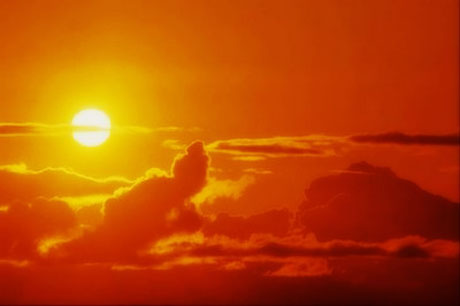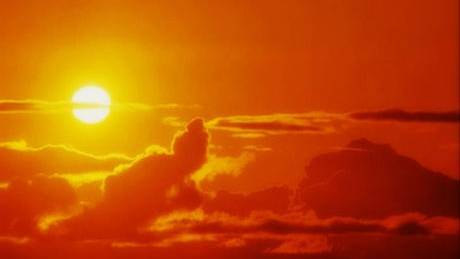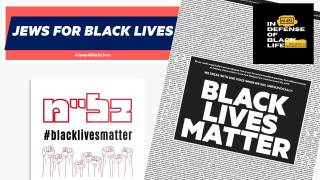Jewish Groups Prepare for Rare Blessing of the Sun
Source: forward.com

As sunrise broke over New York City on the morning of April 8, 1981, Rabbi Zalman Schachter-Shalomi — at the time he was known just as Zalman Schachter — stood on the observation deck of the Empire State Building and sounded the shofar.
For more than two hours after, Shachter-Shalomi led some 300 mostly young adults in an obscure Jewish ritual known as Birkat Hachamah, or blessing over the sun, a prayer recited once every 28 years when, the Talmud says, the sun reaches the same spot in the firmament as when it was created.
According to an account of the service in The New York Times, participants raised their hands in prayer, asked for healing for individuals and the earth, and released 70 balloons. At the conclusion, some worshipers joined in the singing of a Hebrew version of “Let the Sun Shine In” from the rock musical “Hair.”
The rite, Shachter-Shalomi told the Times, “helps us renew our relationship with the solar system and increase our awareness of the sun as a source of energy.”
Twenty-eight years later, Jews across the denominational spectrum are gearing up again for the observance with a range of planned celebrations, many of them environmentally focused. The sun prayer will be said, as it will several times in the 21st century, on April 8, which this year falls on the eve of Passover.
In the northern Israeli city of Safed, an eight-day festival is planned featuring several environmentally and kabbalistically inspired events, including the ceremonial burning of leavened bread on the morning before Passover by concentrating the sun’s rays through an optic lens.
“Over the last 28-year cycle, we have suffered from pollution and the depletion of natural resources,” said the festival founder, U.S.-based artist Eva Ariela Lindberg, in a news release. “Let us use this extraordinary opportunity to co-create the next cycle by seeking alternative solar energies and a purer environment, recharging ourselves and learning how to honor the earth, our neighbors and ourselves. This is a time to renew, and bring fresh blossoms to our world for the next 28-year cycle.”
In the United States, 14 Jewish organizations have joined to launch BlessTheSun.org, a Web site with links to various educational materials and ideas for April 8 activities. The site asks users to sign a Covenant of Commitment in which they “pledge to hasten the day of environmental healing, social justice and sustainable living for all.”
Five of the groups also are sponsoring an art competition for works “interpreting aspects of the sun and exploring the relationship between Judaism and the environment.” And the United Synagogue for Conservative Judaism has designed a 68-page study text on the prayer emphasizing environmental themes.
“Growing up, there was almost a fear in recognizing that our holidays and calendar are indicative of an earth-based religion,” said Nati Passow, co-founder of the Jewish Farm School, one of the groups behind BlessTheSun. “That doesn’t necessarily mean idol worship or earth worship, but it means that the calendar and the cycles were a reflection of people who lived with a greater awareness of natural cycles than we have now. And so any time you can teach people about elements of our tradition that are earth-based, and especially the ones that are hidden and not as well known, it’s a way of bringing people into Judaism.”
The prayer, whose origins lie in the Talmud, blesses God “who makes the work of creation” and is the same blessing said over other rare natural phenomena, like lightning or a meteor.
Its Talmudic origins mean that the sun blessing is hardly the sole province of liberal Jewish environmental groups.
ArtScroll Publications, an Orthodox publishing house, has reissued an updated version of Rabbi J. David Bleich’s seminal 1981 book “Birchas Hachamah,” probably the most definitive English-language treatment of the subject. And Canfei Nesharim, an Orthodox environmental group, is working on a number of initiatives, including a sun-themed mishloach manot — the food baskets traditionally given on the holiday of Purim, which falls about a month before the sun blessing.
Bleich’s book includes a rigorously detailed discussion of the evolution of the Jewish calendar and the complex calculations of lunar and solar cycles that determine the dates of Jewish observances.
“The blessing on this occasion, it would seem, is evocative rather than responsive,” wrote Bleich, a professor of Jewish law and ethics at Yeshiva University. “It is designed to arouse man from his lethargy, to force him to reflect upon this cosmic phenomenon, to summon him to contemplation. Marking yet another solar milestone in the calendar of eternity, the occasion calls out to man: Lift up your eyes on high and see: who created these?”
Despite the complexity of the Talmudic discussion, the determination of April 8 is almost certainly inaccurate, Bleich told JTA. But the sages of the Talmud ordained the blessing not as a precise astronomical commemoration, Bleich said, but as a pedagogic device to impress upon future generations God’s continuing role in sustaining the universe.
Asked about Jewish groups that want to infuse the blessing with an environmental message, Bleich said, “I wish them luck.”






















